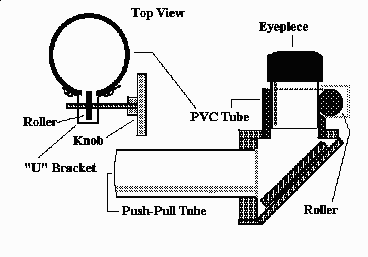Cheap Trick: Low-Tech Focusing Mount
Jack Kramer
Several years ago when I made my current copyscope, to save money I decided to forego a rack-and-pinion focusing mount in favor of a simple push-pull tube attached to the homemade right-angle adapter. This minimalist approach has served adequately, but requires considerable effort to adjust the focus. It's especially bothersome when other observers are looking through your scope and need to re-focus for their own eyes. The problem is that the push-pull tube has to fit quite snugly into the tailpiece of the telescope so as not to slide out when the telescope is aimed overhead. I recalled the slick Crayford focuser that Rich Burns made for one of his scopes and felt the same principle might be applied in a scaled-down way for those of us without the wherewithall to do our own machining. After some playing-around with parts found in my junk drawers, the following creation was hatched.
PVC tubing provides some very useful parts for the telescope maker. Upon finding a piece with an inside diameter of 11/4", it appeared that once the rough focusing range had been achieved with the old push-pull tube, fine focusing might be accomplished by moving just the eyepiece through a short distance. The PVC tube diameter was on the generous side, so the eyepieces seated very loosely. Now how do we tighten up the eyepiece so that it'll stay where you set it, yet allow it to move freely to re-focus? The Crayford design relies on metal rollers that bear against a focusing tube. Using the same principle, a roller could bear directly against the eyepiece barrel. The "plumbing junk" drawer supplied a circular rubber grommet with a small center hole. I found that the rubber had just enough give to provide an easy tension against the eyepiece. A notch cut out of the PVC tube allowed access to the eyepiece barrel. Now how do we hold it in place?
One of the great toys of bygone years was the Erector set. Since I have two daughters, the set I enjoyed as a kid was gathering dust without an heir apparent. So bit by bit, I've been using it for different projects; the handy thing about Erector parts is that they have all those pre-drilled holes. Those of you who had a set will notice some familiar pieces if you look at the spider on my 10" reflector. This time, the Erector set yielded up a "U" bracket, a short axle, and a wheel to use as a knob. The bracket had to be re-bent somewhat in order to properly position the grommet against an eyepiece barrel.
The PVC tube is just smooth enough so that the eyepiece barrel moves freely by hand, yet with enough friction that it stays in place after it's in the desired position. Tension can be reduced as needed by loosening the short screws that hold the "U" bracket to the PVC tube. In order to allow the screws enough material to grab, the PVC tube wall should be no thinner than 1/8", but preferably thicker. The roller is held in place on the axle with a few drops of Super Glue.

My intent was to be able to fine-focus by turning the knob as on a rack-and-pinion mount. However, I found that if the roller tension was adequate to move the eyepiece up and down in the tube, then the effort needed to turn the roller with the knob was so great that the grommet (roller) eventually broke free from the axle. Lessening the tension caused the roller to slip against the eyepiece barrel rather than move it. Spraying the inside of the PVC tube with a silicon lubricant helped. That made the PVC barrel just slick enough for the eyepiece to move fairly smoothly by turning the knob. However, the silicon has to be re-applied periodically. Nonetheless, in the cold weather the roller still broke free. The glue tends to stick more to the roller than to the metal axle, so I ground a flat spot on the axle to allow the Super Glue to "wedge-in". So far, this seems to have solved the problem.
Although you can adjust the eyepiece with your fingers, best focus is easier to achieve using the knob. Either way, it's a lot less of a struggle than with the old push-pull method. The concept seems to have merit and could be finessed somewhat. For example, if the PVC tube were lined with Teflon, that might produce just the right combination of tension versus free movement. Or two guide rollers might be added. For now, the present setup isn't very elegant, but it works just fine.
Published in the February 1994 issue of the NightTimes




